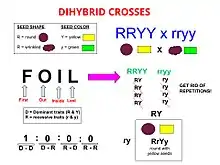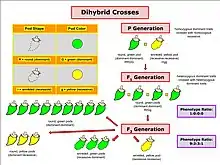Dihybrid cross
Dihybrid cross is a cross between two different lines/genes that differ in two observed traits. We compare two different characteristics in a dihybrid cross.
Its phenotypic ratio is 9:3:3:1, where 9 plants have all dominant characteristics and 1 plant has all recessive characteristic. (Valid only for Angiosperms / similar sexually reproducing organisms)
According to Mendel's statement, between the alleles of both these loci, there is a relationship of completely dominant - recessive traits. In the example pictured to the right, RRYY/rryy parents result in F1 offspring that are heterozygous for both R and Y (RrYy).[1]

In the name "Dihybrid cross", the "di" indicates that there are two traits involved (e.g. R and Y), the "hybrid" means that each trait has two different alleles (e.g. R and r, or Y and y), and "cross" means that there are two individuals (usually a mother and father) who are combining or "crossing" their genetic information.

- The Dihybrid cross is easy to visualize using a Punnett square of dimensions 16:
- The dominant traits are uppercase, and the recessive traits of the same characteristic is lowercase.
- In the following case the example of Pea Plant seed is chosen. The two characteristics being compared are
- Shape: round or wrinkled
- colour: yellow or green
- R (roundness) is dominant and Y (Yellow colour of seed) is Dominant. This implies that Rr will be a round seed and Yy will be a yellow seed. Only rr will be wrinkled seed and yy will be green seed.
| RY | Ry | rY | ry | |
|---|---|---|---|---|
| RY | RRYY | RRYy | RrYY | RrYy |
| Ry | RRYy | RRyy | RrYy | Rryy |
| rY | RrYY | RrYy | rrYY | rrYy |
| ry | RrYy | Rryy | rrYy | rryy |
The rules of meiosis, as they apply to the dihybrid, are codified in Mendel's first and second law, which are also called the Law of Segregation and the Law of Independent Assortment, respectively.
For genes on separate chromosomes, each allele pair showed independent segregation. If the first filial generation (F1 generation) produces four identical offspring, the second filial generation, which occurs by crossing the members of the first filial generation, shows a phenotypic (appearance) ratio of 9:3:3:1, where:
- the 9 represents the proportion of individuals displaying both dominant traits:
RRYY + 2 x RRYy + 2 x RrYY + 4 x RrYy - the first 3 represents the individuals displaying the first dominant trait and the second recessive trait:
RRyy + 2 x Rryy - the second 3 represents those displaying the first recessive trait and second dominant trait:
rrYY + 2 x rrYy - the 1 represents the homozygous, displaying both recessive traits:
rryy - The Dihybrid phenotypic ratio= 9:3:3:1
- The genotypic ratio are: RRYY 1: RRYy 2: RRyy 1: RrYY 2: RrYy 4: Rryy 2: rrYY 1: rrYy 2: rryy 1.
See also
References
- "The Dihybrid Cross" - Open Door Archived February 7, 2010, at the Wayback Machine
